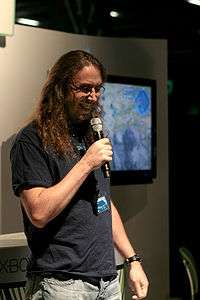Graeme Devine
| Graeme Devine | |
|---|---|
 Graeme Devine at TouchArcade WWDC Party in 2010. | |
| Born |
1966 (age 49?)[1] Glasgow, Scotland |
| Nationality | Scottish |
| Other names | Graeme John Devine |
| Occupation | Chief Creative Officer at Magic Leap |
| Known for | Video game development |
| Spouse(s) | Lori Johnson Devine (1 child) |
Graeme Devine is a computer game designer and programmer who co-founded Trilobyte, created bestselling games The 7th Guest and The 11th Hour, and helped design id Software's Quake III Arena. He was also Chairman of the International Game Developers Association (IGDA) from 2002–2003. One of Graeme's trademarks is his Scooby-Doo wardrobe.[2] He has said of his work that "I've not stuck to any one genre, platform or IP throughout my career, and I hope people eventually work out that's just fine."[3]
Biography
Devine was born in 1966 in Glasgow, Scotland and began his career working on the TRS-80 at age 14 in the late 1970s. He joined Atari at age 16 to port their classic game Pole Position to home computers, including the Commodore 64, Apple IIe and ZX Spectrum. He also worked for Lucasfilm's Games Division, Activision UK, and Virgin Interactive.
Devine founded Trilobyte in December 1990 with Rob Landeros. Together, they designed the original concept of the 1992 horror game The 7th Guest. Graeme was the lead programmer on the game and on its sequel The 11th Hour. The 7th Guest was a phenomenon, selling 2 million copies, and is credited (along with the game Myst) with encouraging the use of CD-ROM drives for games.
Devine was also one of the forefathers of file compression. The game The 7th Guest made extensive use of movie footage, which required a great deal of disk space. Most games in the industry at that point were still shipping on floppy disks, which could only hold about 1 Megabyte of data each. The 7th Guest used roomier CD technology, but there was still a limit to how many CDs could practically be used for a single game. File compression technology at the time, especially for videos which could run into hundreds of megabytes, was still in a primitive state. However, Devine innovated a way to compress movie files, so Trilobyte could fit two hours of footage, along with the game itself, onto only two CDs.[2]
Work for id Software

After the demise of Trilobyte in the late 1990s, Devine joined id Software in 1999 to work as a designer on Quake III Arena and Quake III Team Arena. At id he gained recognition in the Mac gaming community for supporting development on the platform. He also worked on the Game Boy Advance versions of Commander Keen (2001), Wolfenstein 3D, and Doom II, and was a programmer on Doom 3 until he moved to Ensemble in August 2003. Matthew J. Costello, who worked with Devine on The 7th Guest, would also help plot Doom 3 and, like 7th Guest, later novelize it. Devine then took the Lead Designer position for Halo Wars, an RTS for the Xbox 360. In February 2008 Devine was named one of the Top 100 Developers in the Video game Industry.[4]
Work for Apple
In 2009, Devine was hired by Apple. He was in charge of making sure that Apple's iOS devices play games well.[5][6] In December 2010, he left Apple to focus on developing games on iOS devices.[7]
GRL Games
Devine founded GRL Games in Santa Cruz, California in 2010, focused on making games for the iPhone and iPad. According to the company's website, the GRL either stands for "Giant Robot Lizard" or "Graeme Roque Lori." GRL Games' first application, Full Deck Solitaire was released in 2011 along with Clandestiny, Full Deck Word Games, Full Deck Poker Solitaire and Solitaire Minute. GRL Games' announced Dance City on March 10, 2012.[8]
Magic Leap
Magic Leap is a Virtual retinal display system using light fields. The company started in 2010. In 2014, it had raised more than $540 million of venture funding from Google,[9] Qualcomm, Andreessen Horowitz and Kleiner Perkins, among other investors.[10][11] Graeme is their Chief Creative Officer & Senior VP Games, Apps and Creative Experiences.[12]
References
- ↑ Intelius report.
- 1 2 "Haunted Glory: The Rise and Fall of Trilobyte" from GameSpot
- ↑ "A Moment With... Graeme Devine". Retro Gamer (122). Imagine Publishing. December 2013. p. 30.
- ↑ http://www.next-gen.biz/features/hot-100-game-developers-2008
- ↑ "Halo Wars, 7th Guest Dev Lands Job at Apple". Kotaku. 2010-06-07.
- ↑ "Interview: John Carmack and Tom Mustaine on Doom, iPhone Desires, and the Future of id Mobile". Shacknews. 2009-06-23.
- ↑ "Apple Loses Its iPhone Game Guru". Kotaku. 2010-12-08.
- ↑ "How to design a game for your teenage daughter". VentureBeat. 2012-03-05.
- ↑ The company, not its investment arm Google Ventures
- ↑ David Lidsky (October 21, 2014). "So Badass You Can't Believe It". Fast Company.
- ↑ David Gelles and Michael J. de la Merced (October 21, 2014). "Google Invests Heavily in Magic Leap's Effort to Blend Illusion and Reality". New York Times.
- ↑ EmTech Digital, MIT Technology Review. "10 Breakthrough Technologies 2015 - Magic Leap". MIT Technology Review. Retrieved 9 June 2015.
External links
- Graeme Devine profile at MobyGames
- GRL Games Inc., founded by Devine.
- Trilobyte Games, co-founded by Devine.
Audio/video
- Presentation in the Inventing the Future of Games Lecture Series at UC Santa Cruz in 2012 Social Games are Dead!, February 22, 2012